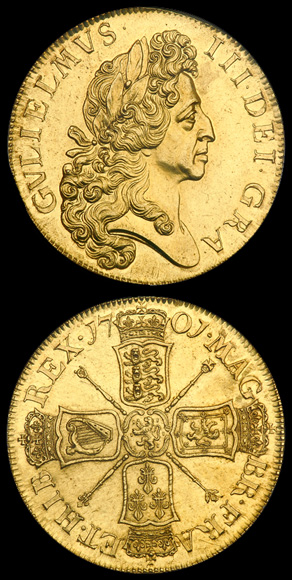English Gold Coins:
English Gold Coins (overview) | Gold Penny | Gold Florin | Gold Noble | Gold Ryal | Gold Laurel | Gold Unite | Triple Unite | Gold Crown | Gold Angel | Gold Guinea | Gold Coins Of The Black Prince | Five Guineas | Gold Sovereigns | Fine Sovereign | Double Sovereign | Two Pound Coin | Five Pound Coin | Gold Proof Coins | Elizabeth II Diamond Jubilee Gold Coins
Five Guineas
Share this page:

Five Guineas (S.3546), William III 1701
Obv. - William III
Rev. - Cruciform shields, sceptres in angles
The five guinea coin is a denomination that first started in the reign of Charles II and continued into be issued until 1753. The guinea coins were superseded by sovereigns in the Great Recoinage of 1816.
In general, five guinea coins were not produced in great quantity compared to the guinea and half guinea - however those that were in circulation saw much use. In general, worn or damaged examples are more common, specimens in high grade significantly more valuable.
Charles II Five Guineas
The first five guinea coin was that of Charles II, and it was initially valued at 100 shillings. Although most people think of the value of the gold guinea as 21 shillings, the guinea was at first worth 20 shillings; being a continuation of the sovereign / unite / broad and other 20 shilling coins of previous times. The name "guinea" was in a sense a nickname, a recognition of the fact that the gold used to make the coins was imported from Guinea, Africa. Fluctuation in the gold price, together with clipping of the nation's silver coins caused the face value of the guinea to be changed several times throughout the life of the coin.
The series of gold guinea coins of Charles II were milled, as opposed to hammered, and the machining process for creating the coins had recently been developed. With a diameter of 37 mm and a weight of 41-42 grams (around 650 grains troy) the five guinea piece was an impressive coin by any standards and would have had tremendous purchasing power in its day. The Obverse featured Charles' portrait with the words CAROLUS II DEI GRATIA ("Charles II by God's Grace"); the reverse featured the cruciform shields, sceptres in angles design that has been seen on other coins since then - for example the silver florins of George V issued from 1911-1920. The five guinea coins featured edge lettering instead of milled edges - with the words "DECUS ET TUTAMEN" and "ANNO REGNI _______" with the regnal year, calculated from the day of the death of Charles I. So for example, coins from 30 Jan 1669 - 30 Jan 1670 read "ANNO REGNI VICESIMO PRIMO".
The gold five guinea coin was first issued dated 1668 and appeared every year for the rest of Charles II's reign (1684). James II issued gold five guineas in 1686, 1687 and 1688; William and Mary issued them from 1691-1694 and William III issued them in 1699, 1700 and 1701. [1]
With the exception of the extremely rare 1677/5 coin with "NONO" ("ninth") edge lettering, all these coins are obtainable, collectable examples generally listing for four figure sums.
Queen Anne Five Guineas
Queen Anne (1702-1714) produced five guinea coins in 1703, 1705, 1706, 1709, 1711, 1713 and 1714. Most of these coins are obtainable, however the 1703 variety is extremely rare and listed at £125,000 in top condition. Of this coin it is said that less than 20 examples exist. Three different obverse dies were used during the manufacture of the 1703 coin, resulting in three slightly different variations. [1] [2]
George I Five Guineas
George I (1714-1727) issued five guinea coins in 1716, 1717, 1720 and 1726. All these coins are somewhat scarce; especially so in Extremely Fine condition. As is common for five guinea coins of this era, the regnal year is written in Latin on the edge of the coin; thus for example the 1720 coin sees the word SEXTO - for "sixth" on the coin edge.
George II Five Guineas
George II (1727-1760) issued five guinea coins in 1729, 1731, 1735, 1738, 1741, 1746, 1748 and 1753. All these dates are obtainable, however a plain-edge 1929 proof and a 1731 proof are listed in catalogues at £37,500 and £40,000 respectively (at fleur-de-coin condition). [2]
George III Five Guineas
No further five guinea coins were issued to the public after those of George II - and after the Great Recoinage of 1816, the denomination was superseded by the five pound coin. However, during the reign of George III (1760-1820), three pattern-only five guinea pieces were minted - dated 1770, 1773 and 1777. These coins are extremely rare and valuable; being listed in catalogues at £100,000 , £90,000 and £80,000 respectively. [2]
References:
[1] Coincraft's Standard Catalogue of English and UK Coins (1998 ed.)
[2] Spink - Coins of England and the United Kingdom
[3] http://www.taxfreegold.co.uk/fivepoundsinfo.html
[4] Robert Lloyd Keynon - "The Gold Coins Of England"




